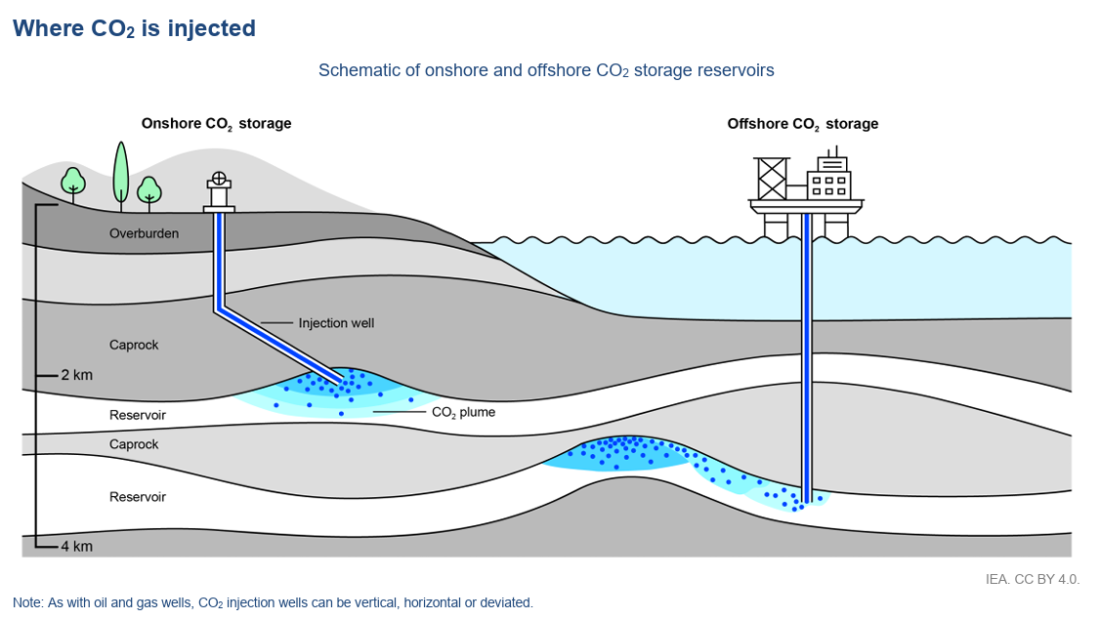Government and private sector initiatives are intensifying toward commercializing carbon capture and storage (CCS). However, CCS is a developing technology with significant risks, requiring careful discussion. The International Energy Agency (IEA) pointed out five key technical risks in the “CCUS Handbook” published in 2022.

The 5 Technical Risks Associated with CCS
(1)Site Performance
Site performance risk is uncertain. At CO2 storage reserves, there is uncertainty whether the planned volume of CO2 can be stored, and it is difficult to accurately calculate the risk in advance. Even after investigating the state of the reservoir through geological surveys and test drilling, there is no guarantee that the planned volume can actually be injected. Injecting beyond the storage capacity risks increasing leakage, while lower-than-expected injectivity and capacity could compromise the overall project’s economics.
(2)Health, Safety and Environment (HSE)
To inject CO2, it must be concentrated at high levels. CO2 present in the atmosphere is harmless, but elevated concentrations of CO2 can lead to human health problems and environmental concerns. The possibility of leaks or blowout of highly concentrated CO2 from CO2 transport pipelines or wells cannot be ruled out. Health hazards from highly concentrated CO2 include headaches and dizziness at 3–5%, affecting breathing rhythm. Concentrations exceeding 7.5% carry the risk of impaired consciousness and shortness of breath, while 10% can cause respiratory distress and loss of consciousness.
Furthermore, beyond human health and safety, prolonged CO2 leakage can cause soil or ocean acidification, inevitably affecting ecosystem dynamics and may lead to ecosystem instability.
(3)Containment
Containment failure is the most extensively researched risk. Monitoring alone is not sufficient. Preliminary test drilling cannot fully characterize the entire reservoir. The speed and volume of CO2 seepage can be difficult to detect or monitor. Leakage from old test pits or legacy wells is also a concern. Furthermore, injecting CO2 may displace groundwater or brine within the reservoir. In particular, subsea CCS poses greater monitoring challenges and careful risk assessment is necessary. In the section of the risk mitigation and remediation, the IEA clearly states that “Injection should cease in the event of a major leak or induced seismicity above a defined threshold. Injection may need to be stopped permanently.”
(4)Induced Seismicity
There are concerns that injecting CO2 underground could trigger earthquakes. In fact, induced microseismic activities have been detected in connection with oil and gas extraction, the injection or extraction of water underground and CO2 storage projects.
(5)Resource Interaction
Storage CO2 activities into reservoirs can have impacts on resources found within the injection zone. There is also a risk of affecting fossil fuels such as oil, natural gas, and coal, as well as groundwater and other resources underground. Groundwater in particularly shallow layers may also be contaminated by the intrusion of saltwater or CO2. The likelihood of interactions depends on the depth of injection, the type and depth of the resources, and CO2 storage site as well as operational conditions (injection volume, speed, etc.). Resource interaction needs to be assessed on a site-by-site basis.
Risk Management
Risk management processes are a key part of CO2 storage assessment, development and operations. The IEA encourages measures to address these five risks. Monitoring is essential not only to manage reservoir pressure and establish systems for rapid detection of leaks and seepage. Also, monitoring surface changes and microseismic activity is equally important. For any of those 5 risks, it is essential to properly manage reservoir pressure, establish systems for rapid leak detection, and maintain long-term monitoring.
Since CO2 storage costs may increase with time due to resource availability and quality, the IEA points out that CCS commercialisation requires policy support.
What Japan Must Do – CCS is the Last Resort
The IEA indicates that CCS will pay a crucial role in decarbonization. However, this does not mean that CCS justifies continuing to use fossil fuels. Considering the significant costs involved in backfilling CO2 into limited sites while managing risks, the IEA suggests that CCS is a major component of the portfolio of technology options to deliver deep emissions reductions in the hard-to-abate sectors. Regions like Japan, where big earthquakes can strike anywhere at any time, are clearly the least suitable for CCS and have extremely high risks. Nevertheless, it is highly problematic that the Japanese government is focusing on supporting CCS projects, including CO2 capture from coal-fired power plants, and is promoting commercialization of those projects while significantly underestimating the risks. JBC intends to continue closely watching the movements of the government and project operators.
IEA:CO2 Storage Resources and their Development
An IEA CCUS Handbook
Reference
IEA:Legal and Regulatory Frameworks for CCUS, An IEA CCUS Handbook (Published: July 25, 2022)
IEA:CCUS Policies and Business Models: Building a Commercial Market (Published: November 26, 2023)
Written/published by: International Energy Agency (IEA)
Published: December 2, 2022
